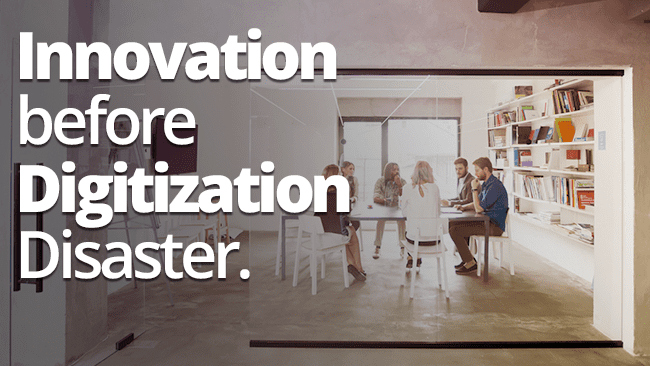 It’s an irrefutable fact that digitization has rapidly moved on from being somewhat of an innovative trend to becoming a core organizational competency. It’s a vital, enterprise-wide strategy affecting every dimension of the operation and driven by the necessity to add intrinsic and measurable value – as perceived by the customers – to the organization’s products or service offerings. What’s more, the strategic direction and on-going support is ideally driven by the Executive team.
However, many organizations struggling to overcome corporate inertia would do well to revisit the base principles of true innovation. It’s not simply the disparate deployment of new or revised or re-engineered processes and a smattering of funky new ‘digital’ technologies. For these are the tell-tale signs of an organization in distress and the early warning signs of a looming ‘digitization disaster.’
In the C-Suite of such organizations, there’s a profound lack of understanding, alignment or common vision for ‘digitization.’ Consequently, the enterprise is fraught with all manner of disingenuous initiatives and misguided efforts, not to mention missed opportunities and sluggish performance. These traits rapidly manifest as executive-level disillusionment with the entire concept of ‘digital.’ And that would be a tragedy.
It’s an irrefutable fact that digitization has rapidly moved on from being somewhat of an innovative trend to becoming a core organizational competency. It’s a vital, enterprise-wide strategy affecting every dimension of the operation and driven by the necessity to add intrinsic and measurable value – as perceived by the customers – to the organization’s products or service offerings. What’s more, the strategic direction and on-going support is ideally driven by the Executive team.
However, many organizations struggling to overcome corporate inertia would do well to revisit the base principles of true innovation. It’s not simply the disparate deployment of new or revised or re-engineered processes and a smattering of funky new ‘digital’ technologies. For these are the tell-tale signs of an organization in distress and the early warning signs of a looming ‘digitization disaster.’
In the C-Suite of such organizations, there’s a profound lack of understanding, alignment or common vision for ‘digitization.’ Consequently, the enterprise is fraught with all manner of disingenuous initiatives and misguided efforts, not to mention missed opportunities and sluggish performance. These traits rapidly manifest as executive-level disillusionment with the entire concept of ‘digital.’ And that would be a tragedy.
Customer Service Solution Innovation
So, let’s take a back-step and explore some of the fundamentals of innovation before we steer our organizations headlong into digital disaster. Henning du Plessis, co-founder of TMARA1 (Target Market Adoption Risk Assessment) defines true innovation as having three fundamental principles:Principle One – Intrinsic Value:
An innovation can only bring benefits if it diminishes a limitation for the market. “Find the limitation that your innovation removes and you have found the key to your market’s sweet spot.”Principle Two – Realizable Value:
Realizable Value will only manifest when the market adopts a new way of doing something; a new rule or set of rules or norms.Principle Three – Guaranteed Value:
(Dependent on achieving Principles One and Two) Any innovation will benefit from a catalyst that helps to accelerate the rate of adoption. For example: ‘Put your money where your mouth is’ is a value guarantee that counts. Once again it is Uber that demonstrates the perfect example of an exponential organization that has certainly achieved incredible success based on the Three Principles of Innovation. The Uber App removed the 100-year-old ‘limitation’ of defined taxi ranks and passengers standing in line or randomly hailing passing cabs. Simultaneously Uber riders quickly adopted to the new ‘norm’; the new ‘rules of engagement’; the new way of doing things and finally, the organization backs up its innovations with its promise of exemplary customer service solutions. In a nut-shell, Uber’s innovations unlocked value; that is, the customers’ perception of value. Voila! And the same can be said for the likes of Airbnb. In an almost parallel way, both organizations catalyze innovative strategies and processes by leveraging digital technologies. But is innovation strictly the realm of start-ups and young, small, agile companies? Not necessarily so. But there are some significant challenges.Overcoming the Corporate Immune System and Crafting a Culture of Innovation
In a world surrounded by exponential companies, great innovators leveraging digital technologies and voraciously attacking market share and revenues, many historically well-established organizations with ‘old school’ leadership models tend to cling ferociously to the idea that innovation is akin to risk; that entrepreneurial thinking is strictly for start-ups. How often have we heard the words “We must preserve and protect our successful past” or, “Our job is to perfect the present.” And the one that will certainly stifle innovation, “We need to become better and better at what we are currently doing.” These are clear-cut examples of how the antibodies of the Corporate Immune System kick in and annihilate even the first vestiges of creativity or innovation. To put it in the words of John L Mariotti2 , “Preserving the Past (PP) and Perfecting the Present (PP) does not equal Finding the Future (FF).” He even created a formula to demonstrate this profound philosophy. PP x 2 ≠ FF Peter Drucker3 put it slightly differently; “The manager’s primary responsibility is the allocation of the best resources to the greatest opportunities – and not to fixing problems born of the past.” Sadly, the reality is that in certain organizations, to create a culture of innovation is like trying to turn a supertanker around in the Panama Canal. It can be done, but it takes a heck of a lot of effort, and it takes a whole lot longer. It goes without saying that to craft a culture of creativity and innovation within any organization, requires that the most senior executive team buys into the model and supports it with on-going passion and unrelenting drive. Innovation must become part of the ethos of the business. As much as the boardroom talks about how innovation is a top priority, few excel at creating a culture of innovation in which employees are truly empowered to generate, develop, and pitch great ideas. Many organizations tend to invest heavily in idea collection platforms, newsletter rhetoric and pay lip-service to the concept of innovation. They then wonder why innovation isn’t happening and why the business is being decimated by the competition. Here are three basic concepts that could potentially unlock massive creative and innovative potential residing within most organizations.Define what Innovation means for the Organisation.
The starting point is for the executive team to reach a consensus of what exactly ‘innovation’ means for and to the organization as a whole; a universally recognized framework highlighting the fact that innovation doesn’t only refer to developing exciting new products or services, but to every conceivable aspect of the organization. The Corporate Immune System will always be a reality. Line managers, in particular, are tasked and incentivised to drive their respective business units to achieve more efficient operations; to reduce costs; to mitigate risks and to meet ever increasing and challenging targets. Line managers’ roles are to ensure optimum performance in the business core activities. The structure itself, therefore, creates often impenetrable roadblocks for innovators and innovation is seen as a threat to productivity.Appoint and Empower Innovation Champions.
One of the keys to unlocking innovative potential in the organization is to appoint and empower respected champions to push back against the immune system. These Innovation Champions should be tasked to provide a safe haven for employees to share innovative thinking or to test new ideas. Also, employees should be given the appropriate knowledge, training, tools, frameworks and other resources with which to flex their innovative individuality. They should be taught how to identify innovative value both from the organization and the customer’s perspectives. Many will need to be taught what to do with their ideas; who should hear about them, how to package the value proposition of the idea and how to pitch it to ensure the best possible chance of success. Create a safe and secure environment for experimentation and evaluation; an environment and a culture that embodies both trust and confidence.Redefine Performance Metrics and Incentives.
In the majority of cases, employees’ performance metrics being centered around productivity and efficiencies, create a counterintuitive mindset. Employees may well have been told to “be innovative,” yet their individual performance targets and remuneration or compensation packages don’t have the elements to create any real incentive to contribute towards organizational innovation. By focusing boardroom attention and applying contemporary leadership thinking about how innovation can serve the enterprise and its customers, vast untapped internal creative resources can be brought into play. However, it will demand that the executive team reimagines and reengineers how employees will be evaluated, incentivised, remunerated and recognized.“Culture Eats Strategy for Breakfast.”
This catch-phrase of the late 60s and 70s epitomizes many of the organizational and management principles of that particular era; it promoted a great deal of either/or-type thinking as if ‘Culture’ and ‘Strategy’ operate in two different corporate universes. In today’s incredibly complex and competitive business landscape, organizations need to craft the balanced triumvirate of Strategies, Capabilities, and Culture. When this is achieved, the organization is ready to embark on its journey of Digitization by Design.[About the author] Dylon Mills is the Director of Marketing Content Strategy & Development at Jacada. As such, Dylon’s main responsibilities are to strategize, create and deliver content for Jacada’s product portfolio that align with the global Go-To-Market strategy, corporate positioning, and marketing campaigns. Dylon’s prior work experience includes Product Management at one of the top Fortune 500 Technology companies, Symantec Corporation. Outside of work, Dylon enjoys problem-solving and any project that includes building/tinkering with tools. Dylon holds a BS Consumer Economics from the University of Georgia.
Dylon Mills is the Director of Marketing Content Strategy & Development at Jacada. As such, Dylon’s main responsibilities are to strategize, create and deliver content for Jacada’s product portfolio that align with the global Go-To-Market strategy, corporate positioning, and marketing campaigns. Dylon’s prior work experience includes Product Management at one of the top Fortune 500 Technology companies, Symantec Corporation. Outside of work, Dylon enjoys problem-solving and any project that includes building/tinkering with tools. Dylon holds a BS Consumer Economics from the University of Georgia.
)